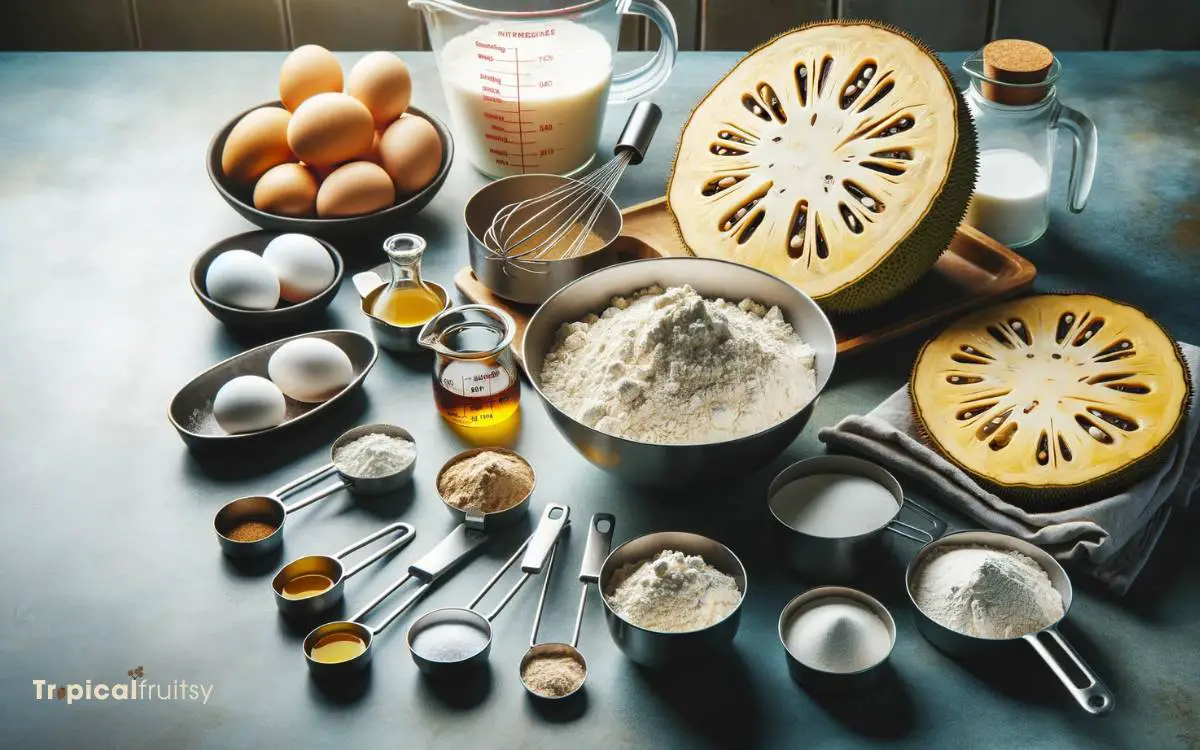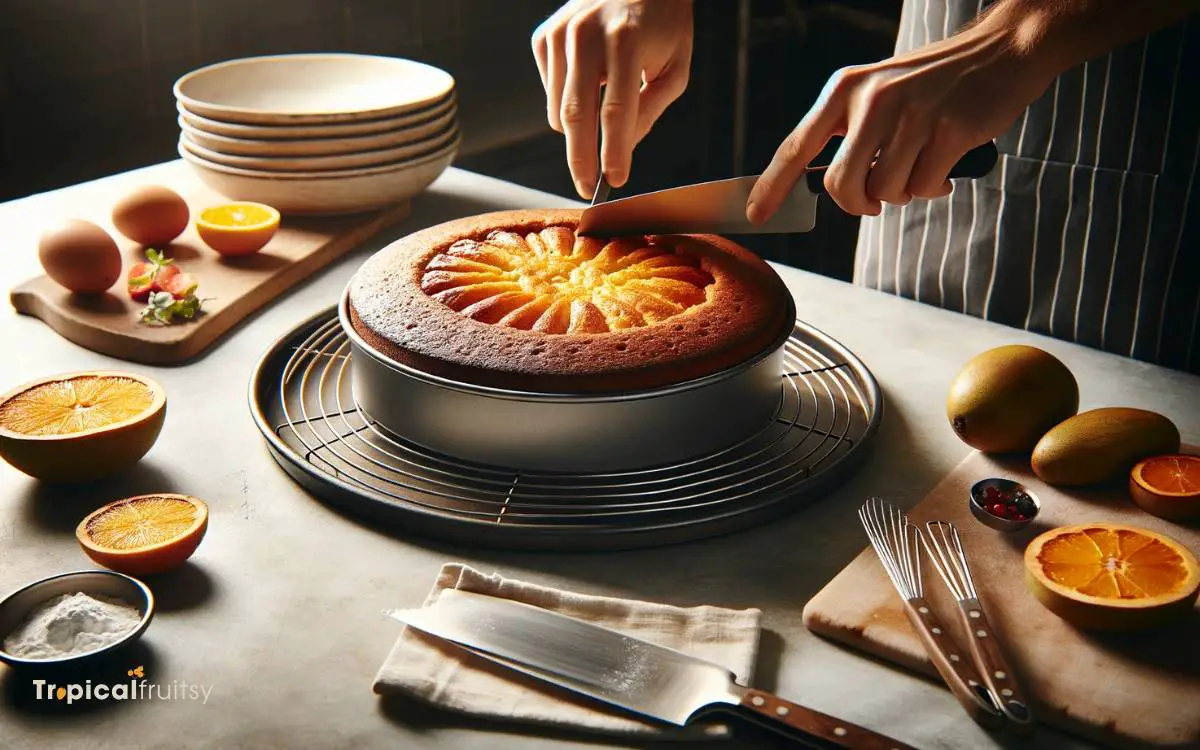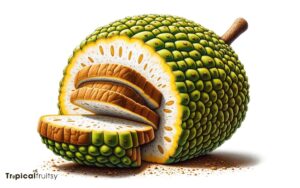How to Make Breadfruit Cake? 5 Easy Steps!
Breadfruit cake, a delightful twist on traditional baking, offers a unique flavor and texture to discerning palates.
Originating from tropical regions where breadfruit is abundant, this cake incorporates the starchy, yet sweet flesh of the fruit, providing a moist and dense consistency.
The preparation involves selecting a ripe breadfruit, which is crucial for achieving the right sweetness and texture.
This introduction will guide you through the essential steps, from sourcing the best quality breadfruit to the intricacies of mixing and baking your cake to perfection.
The process involves creating a harmonious blend of traditional cake ingredients with the distinctive taste of breadfruit.
Whether you are an experienced baker or a culinary enthusiast eager to explore exotic flavors, this guide will equip you with the knowledge to create a delectable breadfruit cake.

Key Takeaway
Step 1: Breadfruit Selection and Preparation

Choosing a ripe breadfruit is the critical first step in preparing a delectable breadfruit cake. This tropical fruit should exhibit a soft, creamy texture and a pleasant, sweet fragrance, indicating it has reached the pinnacle of ripeness.
Its skin, once green, turns to a yellow-brown hue, and the flesh yields slightly under gentle pressure.
Careful handling is paramount to avoid bruising, which could compromise the fruit’s integrity and, consequently, the cake’s quality.
Upon selection, the breadfruit must be cleansed, its outer husk removed with precision to retain as much of the succulent flesh as possible.
The core is then meticulously extracted, creating a perfect canvas for your culinary creation. Mastery in this initial phase sets the stage for a truly exquisite breadfruit cake.
Step 2: Gathering Your Ingredients

Before embarking on the culinary journey of crafting a breadfruit cake, it is imperative to meticulously assemble the necessary components.
A perfectly ripe breadfruit is the cornerstone of your creation, ensuring a rich, nuanced flavor and ideal texture.
Alongside this tropical staple, gather your essential baking supplies and consider any alternative ingredients to cater to dietary preferences or to add an inventive twist to the traditional recipe.
Select Ripe Breadfruit
Securing an optimal breadfruit is essential; select one that exhibits a soft yet firm texture, indicating ripeness, which is crucial for a moist and flavorful breadfruit cake.
The surface should yield slightly to pressure, and the green skin may exhibit a yellowish hue. Sniff the stem end; a sweet, fragrant aroma is a trustworthy indicator of maturity.
Avoid breadfruit with excessive soft spots or blemishes, as these may signal overripeness or decay, which could impart an undesirable flavor and texture to your cake.
| Quality | Indication |
|---|---|
| Texture | Soft yet firm to the touch |
| Color | Slight yellowish hue on green skin |
| Aroma | Sweet fragrance at the stem end |
Choose wisely to ensure your breadfruit cake is a culinary delight.
Essential Baking Supplies
Having selected the ideal breadfruit, one must now assemble the requisite ingredients and baking tools to create a delectable breadfruit cake.
Precise measurements and quality tools are the scaffolding upon which your culinary creation will rise.
To embark on this baking venture, ensure your pantry and kitchen are stocked with:
Ingredients
- Pureed breadfruit for the distinctive, tropical essence
- Granulated sugar to sweeten and golden brown flour to form the foundation
Note:
- Whole wheat flour can be a healthier alternative, but may alter texture
- Leavening agents such as baking powder for lift and airiness
Tools
- A reliable oven, preheated and ready to transform raw ingredients into a warm, inviting dessert
- Mixing bowls and utensils for combining ingredients with precision and care
- Measuring cups and spoons for accuracy in flavor and structure
Alternative Ingredient Options
While the core ingredients are fundamental, several alternatives can be utilized to accommodate dietary restrictions or personal preferences when preparing your breadfruit cake.
If you are baking gluten-free, consider using almond flour or coconut flour as a substitute for traditional wheat flour.
For those avoiding dairy, plant-based milk like almond or coconut milk can replace cow’s milk without compromising the cake’s luscious texture.
Vegans can opt for flaxseed or chia seeds mixed with water as an egg alternative, ensuring the cake’s structural integrity.
Refined sugars can be swapped with natural sweeteners such as honey, maple syrup, or agave nectar to cater to those managing their sugar intake.
Always ensure the substitutes align with the desired consistency and flavor profile of your breadfruit cake.
Step 3: Preparing the Cake Batter

Mixing the ripe breadfruit pulp with the other ingredients is the initial step in preparing the cake batter.
The process requires a gentle yet thorough approach to ensure a uniform consistency, essential for the cake’s texture.
Combining Ingredients:
- Dry mix: Sift together flour, baking powder, and spices to aerate and distribute evenly.
- Wet mix: Cream butter and sugar, then blend with eggs and vanilla for a smooth emulsion.
- Incorporation: Alternate adding dry mix and liquids to the breadfruit pulp, folding delicately to retain air.
A meticulous blend of these components will yield a batter that is both light and rich, ready to undergo the transformation into a delightful breadfruit cake.
Step 4: Baking Your Breadfruit Cake

Once your batter is ready, you should preheat your oven to the recommended temperature to ensure even baking of your breadfruit cake.
Achieving the right oven environment is crucial, as it directly impacts the texture and rise of your confection. Typically, 350 degrees Fahrenheit is a standard temperature for cakes, but always refer to your specific recipe.
After the oven reaches the desired heat level, carefully pour the batter into a greased and floured baking pan, smoothing the top with a spatula. The batter should evenly fill the pan, allowing room for expansion.
Place the pan in the center of the oven to promote uniform heat circulation. Bake until a toothpick inserted into the center comes out clean, which usually takes about 30-35 minutes for a standard-sized cake.
Monitoring the cake’s progress is important; avoid opening the oven door frequently, as this can cause fluctuations in temperature that may affect the cake’s structure.
Once baked to perfection, remove your breadfruit cake from the oven and let it cool on a wire rack before serving, ensuring a delightful texture and optimal flavor.
Step 5: Cooling and Releasing the Cake

The culmination of the baking process is the cooling phase, where the breadfruit cake must be allowed to rest at room temperature to stabilize its structure before being released from the pan.
Cooling Process
- Time Management: Allow the cake to cool for at least 20 minutes to let the flavors meld and the crumb to firm up.
- Heat Distribution: Even after removing from the oven, the cake continues to bake slightly from residual heat.
- Structural Integrity: Rushing the cooling may lead to a cake that falls apart or is too crumbly.
Can I Use the Same Recipe for Making Breadfruit Pudding and Breadfruit Cake?
Yes, you can use the same make breadfruit pudding recipe for making breadfruit cake. The texture and flavor may differ slightly, but the base recipe remains the same. It’s a versatile way to enjoy the unique taste of breadfruit in both dessert options.
Serving and Storage Tips
Once your breadfruit cake has cooled, presenting it at the optimal temperature enhances its rich flavors and moist texture, making it a true culinary delight.
To maintain its freshness, proper refrigeration is key; the cake can be stored in the refrigerator for several days without compromising its quality.
For those who wish to savor this delicacy over time, freezing offers a method to preserve its taste and texture for future enjoyment.
Optimal Serving Temperature
Proper presentation of breadfruit cake entails serving it at room temperature to ensure the flavors are fully appreciated.
The nuances of the cake’s unique taste profile can be compromised if served either too hot or too cold.
Therefore, consider the following guidelines:
Allow the cake to cool:
- After baking, give it ample time to rest.
- A cooling period allows the internal structure to set properly.
Room temperature serving:
- Ideal for maximal flavor release.
- Enhances moisture perception, improving mouthfeel.
Avoid reheating:
- Discourages drying out or toughening the texture.
- Preserves the delicate balance of spices and natural sweetness.
As we delve into the delicate intricacies of flavor and texture, it’s equally important to discuss the cake’s refrigeration shelf life to maintain its quality over time.
Refrigeration Shelf Life
Breadfruit cake, when stored correctly in a refrigerator, can maintain its quality for up to five days.
Ensuring that the cake is wrapped tightly in plastic wrap or placed in an airtight container is critical to preserving its moisture and flavor. It is also advisable to keep the cake away from strong-smelling foods to prevent flavor transfer.
For optimal freshness, consider the following table which breaks down key storage tips:
| Factor | Recommendation | Purpose |
|---|---|---|
| Container | Airtight | Prevents drying out |
| Temperature | 35-40°F (1.7-4.4°C) | Inhibits bacterial growth |
| Placement | Away from odorous foods | Maintains flavor integrity |
| Wrap | Plastic or aluminum foil | Retains moisture |
| Duration | Up to 5 days | Ensures quality |
Freezing for Longevity
To extend the shelf life of breadfruit cake beyond the five-day refrigeration period, consider freezing the dessert as a means of preservation.
Freezing can maintain the cake’s quality for up to three months, ensuring that the nuanced flavors of breadfruit remain intact for future enjoyment.
Preparation for Freezing:
- Cool the breadfruit cake completely to prevent condensation and ice crystal formation.
- Wrap the cake tightly in cling film or aluminum foil to protect against freezer burn and odor absorption.
- Place the wrapped cake in an airtight container or a heavy-duty freezer bag to safeguard its texture and moisture content.
When ready to serve, thaw the cake in the refrigerator overnight. For optimal taste, allow the breadfruit cake to reach room temperature before indulging.
Conclusion
In the culinary tapestry, the breadfruit cake emerges as an intriguing fusion of tradition and innovation, juxtaposing the robust, starchy character of breadfruit against the delicate sweetness of dessert.
This novel confectionery, a blend of tropical heritage and patisserie craft, invites the palate to explore a symphony of textures and flavors.
It stands as a testament to culinary versatility, embodying a harmonious balance between the earthy breadfruit and the refined art of baking.






